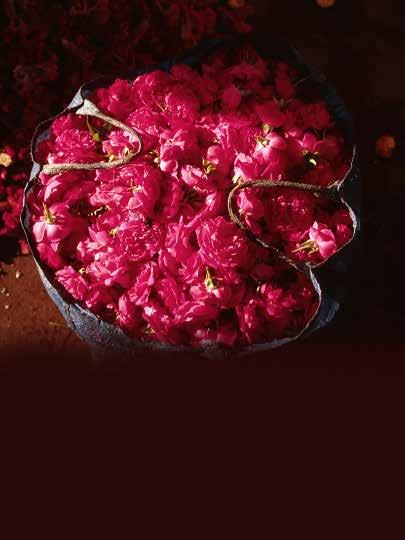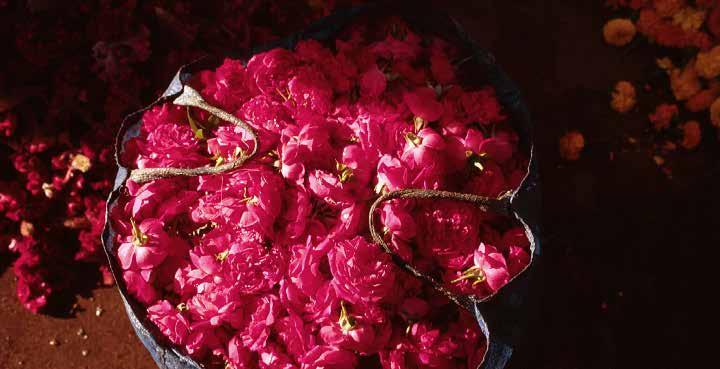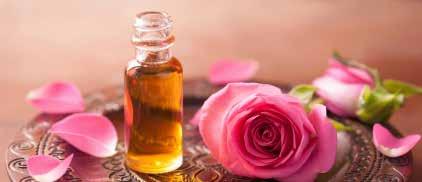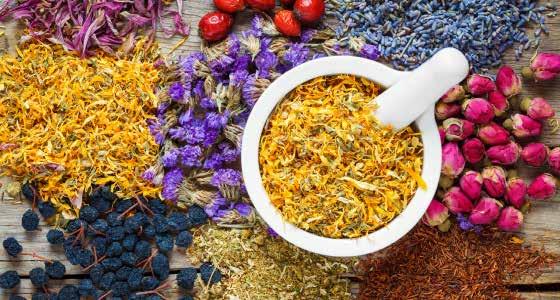by any Other Name
by Dorene Petersen ACHS Founding President American College of Healthcare Sciences

1 Learn well. Live well. Educate others. achs.edu Table of Contents The Real Deal 3 History Tells Us a Story 3 Soil to Oil 4 Inspired to grow them? 4 How do we get those rose petals in the bottle? ................................................................... 5 Getting to Know Your Rose Oil 6 Is your oil pure? ........................................................................................................................ 7 What makes rose oil work? 8 Rose in Your Medicine Chest .................................................................................................. 9 Lets Look at What the Research Says 9 Perfumery ............................................................................................................................... 13 How much can I use? 13 Safety First 14 Regulatory Status 14 Let’s Get Blending 15 About the Author 17 Apothecary Shoppe 18 About ACHS ........................................................................................................................... 19 Disclaimer 20
by Dorene Petersen Founding President American College of Healthcare Sciences
by any Other Name

2 Learn well. Live well. Educate others. achs.edu
“And
—“Maud,” Tennyson (1809-1892)
Figure 1: Rose market, India
the woodbine spices are wafted abroad, And the musk of the rose is blown."
If you’re like me, your heart skips a beat when you receive that bunch of roses on Valentine’s Day, but did you know there really is more than romance involved. Pair your bunch of beautiful rose buds with a deep inhalation of certified organic rose essential oil and you have a power-packed love package that delivers heart health, among other things. Read on to find out why, and—best of all—how to safely use this “love in a bottle.”
The Real Deal
Shakespeare was onto something when he said, “What’s in a name? that which we call a rose/by any other name would smell as sweet.1” But for those of us who rely on plant names to be accurate, the name is everything. For those of you who know me or have heard me speak on aromatherapy, you know that I insist on using Latin names. This way you can be sure you are indeed getting the real deal, and let’s face it … rose essential oil is expensive. The rose I prefer to use for essential oil therapy is Rosa damascena (Mill.) and the botanical family it belongs to is Rosaceae.
There are actually more than 250 rose species, but the three primarily distilled for rose essential oil are R. damascena, Rosa centifolia (L.), and Rosa gallica (L.). R. damascena is cultivated and produced mainly in Bulgaria, as well as regions of Turkey and, to a lesser extent, in Tunisia, China, and India. In France, R. gallica is the species usually grown for perfume. R. centifolia is also distilled in small quantities in Morocco.
History Tells Us a Story
Imagine living in a time when rose petals were used to cover floors, baths were filled with rose petals, and roses were scattered at feasts and beneath chariot wheels. Those Romans sure knew how to live!
The word rosa actually comes from the Greek word rodon, meaning red, and the rose used by the Greeks was a deep crimson color. Referred to as the “Queen of Flowers” by the Greek poet Sappho, the Greeks cultivated the rose and the Romans made extensive use of it. Avicenna first prepared rose water in the 10th century, and the oil of rose was discovered between 1582 and 1612.
An enchanting story is told of the discovery of rose oil. At the wedding feast of Shah Jahan, who built the Taj Mahal and Shalimar Gardens for his wife (now that is a love story), a canal circling the whole garden was dug and filled with water and rose petals. The heat of the sun separated the water from the essential oil of rose. The bridal pair observed this when they were rowing on the fragrant water; the oil was skimmed off and found to be an exquisite perfume, thus beginning rose distillation in India. There also is an old custom of hanging a rose over a dinner table to ensure dinner conversation will be held in confidence. This comes from the folktale that Cupid gave a rose to the God of Silence as a bribe, so that the God of Silence would not reveal the amorous ways of Venus.
Initially, rose oil was the by-product of rose water, which was the primary product.
3 Learn well. Live well.
achs.edu
Educate others.
1 Shakespeare, W. Romeo and Juliet. Act II. Scene II
Soil to Oil
The fresh flowers of the damask rose R. damascena and other species are used to produce rose essential oil. Handpicking rose flowers is hard work. I tried it early one morning alongside Turkish women whose livelihood depended on the weight of each flower- brimming basket. The skill is to pick only the flower with very little stem and no leaves, while avoiding getting stuck with thorns and scratched up bleeding hands. It’s slow going as it takes 30 handpicked flowers, or about 2,000 petals, to yield 1 drop of rose essential oil. R. damascena yields the essential oil known as otto of rose, or attar of rose. Attar means “essential oil” in Arabic. R. damascena is steam distilled from the whole flower petals minus the calyx. “May” rose is an absolute grade that is produced from a concrete extraction of R. centifolia.
Inspired to grow them?
Roses flourish best in a sandy or light, stony soil in full sun, and with good drainage. They are grown from either roots or cuttings planted out in rows in autumn or the early spring. In the first year, no flowers appear and only a few appear in the second year. More flowers appear in the third year, with a maximum between the fourth and 10th years. The rose is rejuvenated after 10 seasons by removing the branches and as new shoots appear, the crop is harvested in the second year.
Rose trees can be productive from anywhere between 10 to 30 years. A half-acre of land will hold about 5,000 roses and can produce 2,200 lbs. of flowers during a season. Experts say that roses cultivated at altitudes of 1,000 to 2,700 feet in the Balkans are superior to any grown at low altitude.


4 Learn well. Live well. Educate others. achs.edu
Figure 2: My rose harvesting teachers.
Figure 3: Women harvesting roses in Turkey.
How do we get those rose petals in the bottle?
In Turkey, roses are grown on hillsides in long, horizontal, evenly spaced rows. Women with large wicker baskets hanging down their fronts and secured by back straps quickly move along the rows plucking the flowers. Plucking just the flower with no leaves or stem and avoiding the thorns, as I said, is a skilled technique that also improves the women’s take home pay. The presence of leaves or stem reduces the value that the distiller will pay for the crop. The flowers are delivered to the distillery and are distilled on the same day. Harvesting takes place in the late spring or early summer, and the weather during the rose harvest greatly influences the quality and quantity of the oil. Dry, hot weather usually gives a poorer yield.
Women start to gather the rose flowers in the very early morning before the sun rises, and they complete the harvest before the midday sun has started to evaporate the volatile constituents, reducing the aromatic quality.
The yield is quite low. To obtain 1 lb. of oil, about 10,000 lbs. of rose flowers have to be distilled. Rose oil is either steam or water distilled. Distilled rose oil is called rose otto or rose attar.

Rose absolutes are also produced but not as common. The volatile components are extracted by solvents or carbon dioxide extraction of the rose petals. The yield of oil from a solvent extraction is approximately 24% of the weight of the flowers and is more efficient than steam distillation. However, the extraction method can impact the active constituents found in the final product.
Author’s Note: While I was participating in the rose harvest with the women in Turkey (see the pictures on the previous page), I noticed the fields were littered with pesticides and herbicides. While herbicides are typically water- soluble and, therefore, would not be absorbed by the plant, pesticides are oil-soluble, absorbed into the plant, and end up in the essential oil. It is important, therefore, to use certified organic, or at least spray-free essential oil. However, note spray-free is an unregulated term.
5 Learn well. Live well.
achs.edu
Educate others.
For essential oil therapy purposes the steam distilled, certified organic rose is my preference. An absolute that is extracted using a “green” solvent, such as ethanol or carbon dioxide, can also be used for external application if a distilled rose is unavailable. Don’t use the absolute in cooking or any preparation you intend to use internally.
Get to Know Your Rose Oil

Here the fun starts. We get to use all our senses to evaluate rose. This is called organoleptic testing, and the more you do it the better you will be at it. Like anything, practice makes perfect.
Start by taking a look at the color. Distilled rose oil is a pale yellow with an occasional green tinge. The absolute is a viscous liquid ranging from folive-yellow to brownish, orange-red. The aroma of distilled rose essential oil is sweet, yet note the intriguing spicy but floral aroma. On your desk or in a warm room it will appear liquid, but in a colder temperature it should form a semi-solid crystalline mass. In the freezer it should be solid. When it is cold enough, you will see it separates into white or colorless blades of crystals, but it has to drop below 21°C (70°F). Go ahead and try this—it will not damage your oil. This is actually an easy test for purity. It is a great way to spot any undisclosed diluents, which remain in a liquid form and usually separate out. Try tasting it. Don’t worry—just use a tiny drop on the tip of your tongue. It is safe as long as you are not pregnant (rose is on the FDA Generally Recognized as Safe (GRAS) list). It can taste slightly bitter, but the more you dilute it, the more the pleasant flavor lingers. If you are a perfumer and have perfume blotters, drop a few drops on the blotter. It should not leave a stain.
Lastly, feel it by rubbing it between your thumb and third finger. It should feel only slightly oily.
6 Learn well. Live well. Educate others. achs.edu
Your rose oil is a precious commodity— treat it with TLC! Store it somewhere cool, in an airtight glass container, and protect it from light. In Turkey, you can still find metal vintage containers that are sealed with a wax.
For those of you who love to read essential oil Material Safety Data Sheets, you can look for these identifiable quality standards for rose oil:
• Congealing Point: +18º to 23.5
• Specific Gravity: +At 20º/15º .856 to .870
• Optical Rotation: -1º to -4º
• Refractive Index: At 25º 1.452 to 1.466
• Solubility in Alcohol: Even in 90% alcohol it is only slightly soluble giving turbid cloudy mixtures

Is your oil pure?
Because rose oil is so expensive, it is frequently adulterated. Synthetic oil is often passed as natural rose oil, but as you train your nose and practice your organoleptic techniques, you will become an expert at detecting this. Even naturally sourced adulterants can be added, such as geraniol and l-citronellol extracted from geranium Pelargonium graveolens (L'Her). oil. This adulteration is difficult to detect through chemical analysis. If you are an expert, careful olfactory tests may detect their presence. Gildemeister2 says that guaiac Bulnesia sarmienti (Lorentz ex Griseb.) wood oil is also used as an adulterant, but this can be detected with a microscope when the oil is cooled and crystallized. The guaiac wood oil crystals are long with a canal-like groove in the middle, while a rose crystal is smaller and thinner with sharply articulated shapes.
A remarkable difference between synthetic and natural rose oil is that synthetic rose is almost entirely deodorized by iodine, while natural rose oil is unaffected. This is another great test to try if you are unsure of the source.
To assess the strength of rose oil, try the following test: drop an equal amount of oil from a number of different sources onto perfume blotters. Mark each perfume blotter with the source. Leave them at room temperature in identical environmental conditions. For 10 consecutive days, check the aroma between 10 a.m. and 11 a.m. Record the results with the following point allocation: strong = three points, medium = two points, and weak = one point. After the 10th day, add the points. Those oils with the highest points are most likely unadulterated.
Another olfactory test that helps to confirm the results of the strength test is the bouquet test. Take your samples of rose oil that you have sourced from different suppliers and, in clean brandy glasses, add 1 drop of rose to 3.5 ounces of distilled water at 108°F. Use the same oils that you used for the strength test. Examine each glass carefully by inhaling deeply and slowly, and place them in order of preference.
7 Learn
Live
achs.edu
well.
well. Educate others.
2 Gildemeister, E., Hoffmann, F., & Kremers, E. (1900). The Volatile Oils, Volume 11. Milwaukee: Pharmaceutical Review Publishing Co: 574.
Figure 4: Example vintage essential oil container sealed with wax.
Repeat the process every hour for six hours, then again the following morning. Note the order after each examination. You will most likely find that certain samples consistently take first place. Now cross-reference your results with the strength test.
What makes rose oil work?
Rose oil is a complex array of active constituents. Just some of them are listed below. This is another reason why rose oil is so hard to duplicate synthetically.
Phenylethyl alcohol (78.38%) was found to be the main constituent of rose absolute, while citronellol and geraniol were the major compounds (>55%) of rose essential oil3. The rose absolute contains more betacarotene and vitamin E (alpha and gamma tocopherol) than the essential oil.
Steam-distilled rose oil contains more than 275 constituents, including:
• The terpene alcohols geraniol, l-citronellol, nerol (5%), and l-linalool. Geraniol and citronellol suggest an antiseptic, antibacterial, antiviral, and germicidal effect.
• The phenols eugenol (1%) and methyl eugenol: eugenol and the sesquiterpenes may be responsible for the topical analgesic effect.
• The aldehydes citral and nonyl aldehyde. Rhodinol, which is also called l-citronellol, is present in highquality oil (40-65%). The alcohols also occur in ester form, such as geranyl acetate.
• Up to 3% phenylethyl alcohol is sometimes found in traces, but is usually lost in the distillation water because of its water solubility. Rose absolute, which is extracted with a solvent, contains more phenylethyl alcohol; Gildemeister in The Volatile Oils, Volume 11, says this is an important aromatic ingredient and without it rose does not truly correspond to the natural perfume of the true rose. This is why rose hydrosol is such a wonderful aromatic product with many therapeutic, culinary, and perfumery applications.
• Phenylethyl alcohol (78.38%) was found to be the main constituent of rose absolute, while citronellol and geraniol were the major compounds (>55%) of rose essential oil. The rose absolute contains more beta- carotene and vitamin E (alpha and gamma tocopherol) than the essential oil4 .
• Traces of sesquiterpenes have also been found with azulene-like qualities.
• It also contains about 2% of a sesquiterpene alcohol and farnesol, which has an analgesic effect and is an important constituent for perfumery.
• Also important for perfumery are the esters, the nerol, the nonyl aldehyde, and trace constituents, such as carvone and rosefuran.
4 Ulusoy, S., Boşgelmez-Tinaz, G., & Seçilmiş-Canbay, H. (2009). Tocopherol, carotene, phenolic contents and antibacterial properties of rose essential oil, hydrosol and absolute. Curr Microbiol, 59(5):554-8. Epub 2009 Aug 18.
8 Learn well. Live well.
achs.edu
Educate others.
3 Ulusoy, S., Boşgelmez-Tinaz, G., & Seçilmiş-Canbay, H. (2009). Tocopherol, carotene, phenolic contents and antibacterial properties of rose essential oil, hydrosol and absolute. Curr Microbiol., 59(5):554-8. Epub 2009 Aug 18.
Rose in Your Medicine Chest
We don’t automatically reach for our rose oil when we have an owie. But you may be surprised to learn it is an effective topical analgesic. That action, coupled with its antibacterial and antifungal actions, provides a powerful but pleasant-smelling therapeutic application with potential supportive application for a number of issues you may have to deal with at home or while traveling. Here are just a few: abrasions, rashes, sores, tinea, thrush (oral), and both mouth and tongue ulcers. My brother-in-law, who was a pilot in the U.S. Airforce, attested to this. Apparently, tongue and mouth ulcers are common in pilots who fly jets, and he was so impressed with the results he had his entire squadron use rose oil. I loved the idea that fighter pilots were high on rose oil!
For simple acute skin infections, rose is diluted at a 2% dilution in boiled, cooled water and applied as a compress on sterile gauze. Additional skin support for broken capillaries and potential UV protection5 has been suggested, primarily due to the presence of antioxidant flavonoids, which are not generally found in distilled essential oils. For this effect, try an infusion of fresh or dried rose petals or use rose absolute. Do you reach for your rose when you feel a cold coming on? You can use it as an inhalation or use a few drops on a sugar cube or lactose tablet for a range of respiratory issues, such as coughs, fever, hay fever, throat (sore), and tonsillitis. The latter would be best supported with gargling the diluted oil in boiled, cooled water. Digestive and urinary system issues can also be aided by rose oil, such as diarrhea, flatulence, fluid retention, gallbladder (congestion), headache, indigestion, nausea, and urinary tract infection. Try a few drops in boiled, cooled water; however, it is important to remember that oil and water do not mix and some of the oil may be lost on the cup. If you don’t mind the taste, drop the rose oil onto a ½ teaspoon of cold pressed oil and take it that way. Or, you can use on a sugar cube or on a lactose tablet.
Psychological and emotional support is also attributed to rose when added to a bath blend or diffused in the atmosphere. It is said to counteract a lack of cheerfulness (such as in depression), specifically with postnatal, stress- induced insomnia, a lack of concentration, reduced memory function, and stress.
Other notable uses are support for a low libido and liver congestion and protection. Last, but definitely not least, rose is a wonderful support for the heart and the entire cardiovascular system. Traditionally, it was used to support normal blood pressure. The results of a South Korean study indicate that R. damascena and its flavonoids may be effective to improve the cardiovascular system6
Let’s Look More Closely at the Research
A 2013 randomized blind clinical trial performed in Egypt used an essential oil blend made of cinnamon, clove, rose, and lavender in an almond oil base on a group of nursing students suffering from primary dysmenorrhea. The experimental group received a massage with the essential oil blend once a day for one
5 Tabrizi, H., Mortazavi, S.A., & Kamalinejad, M. (2003). An in vitro evaluation of various Rosa damascena flower extracts as a natural antisolar agent. Int J Cosmet Sci., 25(6):259-65.
6 Kwon, E.K., Lee, D.Y., Lee, H., Kim, D.O., Baek, N.I., Kim, Y.E., et al. (2010). Flavonoids from the buds of Rosa damascena inhibit the activity of 3-hydroxy-3-methylglutaryl-coenzyme a reductase and angiotensin I-converting enzyme. J Agric Food Chem., 58(2):882-6.
9 Learn well. Live well. Educate
achs.edu
others.
week prior to onset of menstrual cycle. The control group received the same massage protocol but with just almond oil. In the second phase of the trial, the groups switched treatment protocols. In both phases of the trial, the group receiving the essential oils had less pain, bleeding, and duration of menstruation7
ANTIBACTERIAL
In a 2010 study, 10 essential oils, namely, mint Mentha spicata (L.), ginger Zingiber officinale (Rosc.), lemon Citrus limonum (Risso), grapefruit Citrus paradisi (Macf.), jasmine Jasminum grandiflora (L.), lavender Lavandula angustifolia (Mill.), chamomile (German) Matricaria chamomilla (L.) (now called Matricaria recutita (L.)), thyme Thymus vulgaris (L.), rose R. damascena, and cinnamon Cinnamomum zeylanicum (Blume), were tested for their antibacterial activities towards Propionibacterium acnes and in vitro toxicology against three human cancer cell lines. Thyme, cinnamon, and rose essential oils exhibited the best antibacterial activities towards P. acnes at a 25% dilution8
A March 2010 study also showed positive antimicrobial activity of rose against Candida albicans and methicillin- resistant Staphylococcus aureus9
Another study of interest in 2009 in Isparta, Turkey (where the rose industry flourishes), looked at the antioxidant and antibacterial activities of rose hydrosol, rose absolute, and distilled rose. It found rose absolute and essential oil contained high levels of phenolics and demonstrated strong antibacterial activity against Escherichia coli, Pseudomonas aeruginosa, Bacillus subtilis, Staphylococcus aureus, Chromobacterium violaceum, and Erwinia carotovora (causes decay in stored fruits and vegetables) strains10.
ANTICONVULSANT
A 2011 animal study found the extracts of rose to have an anticonvulsant effect in rats. Rats pretreated with rose extract had delayed onset and fewer occurrences of seizures (induced seizures by injection)11.
ANTIOXIDANT
A 2013 study conducted on animals and published in the Journal of Natural Medicine showed rose absolute provides protection in rat brains. Treatment with diffused rose absolute induced protection from depression induced by administering mild stress12
7 Marzouk, T.M., El-Nemer, A.M., & Baraka, H.N. (2013) The effect of aromatherapy abdominal massage on alleviating menstrual pain in nursing students: a prospective randomized cross-over study. Evid Based Complement Alternat Med., 2013:742421.
8 Zu, Y., Yu, H., Liang, L., Fu, Y., Efferth, T., Liu, X., et al. (2010). Activities of ten essential oils towards Propionibacterium acnes and PC-3, A-549 and MCF-7 cancer cells. Molecules, 15(5):3200-10.
9 Talib, W.H. & Mahasneh, A.M. (2010). Antimicrobial, cytotoxicity and phytochemical screening of Jordanian plants used in traditional medicine. Molecules, 15(3):1811-24.
10 Ulusoy, S., Boşgelmez-Tinaz, G., & Seçilmiş-Canbay, H. (2009). Tocopherol, carotene, phenolic contents and antibacterial properties of rose essential oil, hydrosol and absolute. Curr Microbiol, 59(5):554-8. Epub 2009 Aug 18.
11 Hosseini, M., Ghasemzadeh Rahbardar, M., Sadeghnia, H.R., & Rakhshandeh, H. (2011). Effects of different extracts of Rosa damascena on pentylenetetrazol-induced seizures in mice. Zhong Xi Yi Jie He Xue Bao, 9(10):1118-24.
12 Ibid.
10 Learn well. Live well. Educate others. achs.edu
CYTOGENIC
A 2013 study in Saudi Arabia looked at the solvent extracted rose (concrete and absolute) from R. damascena triginitipetala (Dieck), known as Taif rose in the region. The conclusions showed that the absolute had antimutagenic activity when tested on cultures of normal human blood lymphocytes13
HEPATIC
A 1988 study using rats showed rose oil provided protection for the liver. The rats had ethanol-induced liver dystrophy. At a dose of 1.01-ml/kg and 0.5-ml/kg, dystrophy and lipid infiltration were less and glycogen levels were almost completely restored. There was regeneration of liver cells. Unfortunately, the botanical source of the rose oil was not given14
IMMUNOSTIMULANT
A two-week randomized, double-blinded, placebo-controlled clinical trial evaluated the efficacy of rose essential oil in treating recurrent aphthous stomatitis (canker sores). Canker sores are a common noncontagious mouth ulcer that has no known cause; however, occurrences can be triggered by stresses to the immune system. The participants given mouthwash containing rose essential oil had lowered pain, size, and number of ulcers. More research is needed to find if this is an effective long-term treatment for recurrent aphthous stomatitis15
NERVINE
An older 1969 study using 48 medical students tested the neuro-psychic effect of rose, lavender, and geranium. The study showed an increase in concentration capacity, improved attention span, and a faster reflex action when a 1% solution of the oils was sprayed into the room16
TONIC (CARDIAC)
Rose extract was shown to effect both the contraction of the heart muscle and (inotropic) and the heart rate (chronotropic) in an animal study performed on guinea pigs. Inotropic drugs affect the force of heart contraction. Chronotropic affect the rate of heart contraction. The researchers felt this action would be supportive of a weak heart17.
13 Hagag, H.A., Bazaid, S.A., Abdel-Hameed, E.S., & Salman, M.(2013). Cytogenetic, cytotoxic and GC-MS studies on concrete and absolute oils from Taif rose, Saudi Arabia. Cytotechnology, 2013 Oct 8. [Epub ahead of print]
14 Kirov, M., Burkova, T., Kapurdov, V., & Spasovki M. (1988). Rose Oil: Lipotropic Effect in Modeled Fatty Dystrophy of the Liver. Medico Biologic Information, 3:18-22.
15 Hoseinpour, H., Peel, S.A., Rakhshandeh, H., Forouzanfar, A., Taheri, M., Rajabi, O., et al. (2011). Evaluation of Rosa damascena mouthwash in the treatment of recurrent aphthous stomatitis: a randomized, double-blinded, placebo-controlled clinical trial. Quintessence Int., 42(6):483-91.
16 Tasev, T., Toleva, P., & Balabanova, V. (1969). The neuro-psychic effect of Bulgarian rose, lavender, and geranium. Folia med, 11(5):3070317.
17 Boskabady, M., Vatanprast, A., Parsaee, H., & Boskabady, M. (2013). Possible mechanism of inotropic and chronotropic effects of Rosa damascena on isolated guinea pig heart. DARU Journal of Pharmaceutical Sciences, 21(1):38.
11 Learn well. Live well. Educate others. achs.edu
HOUSEHOLD USES
It was Hippocrates who said “Let food be thy medicine,” and the delicious and delicate flavor of rose essential oil and hydrosol make this easy to do. Rose oil is an exquisite and luxurious addition to butter, syrup, jam, and honey. Rose water or rose hydrosol is used in desserts, pastries, and cakes. It is on the USA Food and Drug Administration’s GRAS list, which includes substances that are Generally Recognized as Safe for their intended use. You still may wonder, however, “Is it safe?” I’m sure you’ve heard something to the effect of, “never use oils internally.” As I said, I always recommend certified organic essential oils. Imagine standing in a field or aromatic rose flowers at 5 a.m. in the morning only to find navigating the steep field required avoiding the spent drums of pesticides. My journey to the rose producing area of Turkey allowed me to witness first-hand how heavily sprayed rose fields can be. When cooking with GRAS essential oils, always start with a tiny amount. You can always add more18. The suggested use level is 0.02-0.05-mg%*.
*The notation mg% = milligrams per 100 grams = thousandth of one percent. One mg% equals ten parts per million (10 ppm)19. This is a flavoring standard. Rose oil has a high level of flavoring and fragrance potential, so only very small quantities need to be used.

18 http://www.accessdata.fda.gov/scripts/cdrh/cfdocs/cfcfr/CFRSearch.cfm?fr=182.20
19 Arctander, S. (1994). Perfume and Flavor Materials of Natural Origin. Carol Stream, IL: Allured Publishing Corporation.
12 Learn well. Live well. Educate others. achs.edu
Perfumery
If you are a budding perfumer, rose is an essential oil in your repertoire. When 100 perfumers selected a standard for a floral aroma, Bulgarian rose was the one chosen. The absolute is unique in that it has a high tenacity alongside a deep, rosy fragrance.
Distilled rose otto has more top note, and absolute rose has more fixative power. Rose oil has a warm, deep floral, slightly spicy, rich, honey-like odor.
Rose is a very popular fragrance in many cosmetics and creams, as well as perfumes, toilet preparations, lozenges, and toothpaste. Try a tooth powder with baking soda, and a few drops each of rose R. damascena and mastic Chios mastiha essential oils.

If you are creating an uplifting fragrance, rose is the perfect choice. Try blending it with floral essential oils, particularly jasmine J. grandiflora. There are many other oils it blends well with. A few include: anise
Pimpinella anisum (L.), benzoin Styrax tonkinensis (Pierre) Craib ex Hartwich, bergamot Citrus aurantium (L.) var. bergamia, black pepper Piper nigrum (L.), chamomile (Roman) Chamaemelum nobile (L.) All., costus
Aplotaxis lappa (Decne.), fennel Foeniculum vulgare (Hill), geranium P. graveolens, ginger Z. officinale, immortelle Helichrysum italicum (Roth), neroli Citrus aurantium (L.) var. amara, orris root Iris ×germanica nothovar. florentina (Dykes), patchouli Pogostemon cablin (Benth.), sandalwood Santalum album (L.), vetiver Vetiveria zizanioides (Nash), and ylang ylang Cananga odorata (Lam.) var. genuine. A small quantity goes a long way. The minimum perceptible is 0.01-0.02-mg%.
How much can I use?
The recommended daily dosage (RDD) is for clinical aromatherapy and 1-3 times daily is suggested unless stated otherwise:
• Adult: 1 drop three times daily on a sugar cube or lactose tablet
• External: 1 to 4 drops in the bath
13 Learn well. Live well. Educate others. achs.edu
Safety First
Safety is very important with all essential oils, and more does not equal more effective. Any substance in excess will be toxic. It is all about dose and duration. The toxic constituent is citronellol. It is contraindicated during the first trimester of pregnancy. A 1988 study on pregnant rats showed a daily dose of 0.1-ml/kg of rose oil had no teratogenic effects on the rat embryos. At doses as high as 50% of the known LD50, there was slight toxicity to the embryo20
In rare cases, it may cause dermatitis. The steam-distilled certified organic rose is more suitable for internal use. The toxic rating is I21 and a skin patch test is required.
Regulatory Status
As we learned earlier in this eBook, rose essential oil is listed on the FDA Generally Recognized as Safe (GRAS) list22. The website address has been included in the footnotes if you would like to explore this list further.

20 Kirov M., Vergieva T., & Spasovski M. (1988). Rose oil, Embryotoxic and Teratogenic Activity. Medico Biologic Information, 3:15-17.
21 Toxic Rating: I = Low, II = Moderate, III = High (Low Therapeutic Margin)
22 http://www.accessdata.fda.gov/scripts/cdrh/cfdocs/cfcfr/CFRSearch.cfm?fr=182.20 accessed 9/13/13
well. Live well. Educate others.
14 Learn
achs.edu
Let’s Get Blending!
ROSE WATER OINTMENT
1 ounce sweet almond oil
½ ounce beeswax grated
2 ounces rose water
8 drops rose Rosa damascena essential oil
Melt the beeswax and almond oil over a water bath. Remove from heat and cool until lukewarm. Beat in the rose water until the ointment emulsifies, and then add the 8 drops of rose essential oil. Transfer to a jar of your choice, label, and store in a cool place. Use within 3 to 6 months.
BABY MASSAGE OIL
4 ounces sweet almond oil
1 to 2 drops rose Rosa damascena essential oil
1 to 2 drops chamomile (Roman) Chamaemelum nobile essential oil 2 to 3 drops tangerine Citrus reticulata essential oil
Mix all of the oils together in a clean bottle and label. Apply as massage oil. Use with infants three months or older to support rest and relaxation.
BASIC BODY SCRUB RECIPE
1/8 cup white clay
¼ cup ground oatmeal
¼ cup ground almonds
¼ cup kelp powder
¼ cup powdered roses (you can also substitute lavender Lavandula angustifolia or peppermint Mentha piperita var. vulgaris)
2 to 3 drops rose Rosa damascena essential oil
Mix together and then add water to make a paste. Rub paste into face and scrub body. Wash off. Add an additional base oil for an oil-rich scrub.
15 Learn well. Live well. Educate others. achs.edu
AROMATIC ROOM SPRAY
To make a 2-ounce room or body spray, mix 60 drops of your aroma concentrate with 2 ounces of distilled water or witch hazel hydrosol. Shake well. Spray upward into the air and walk underneath. If the aroma is not strong enough, add more concentrate in 5-drop increments and test again.
HOLIDAY ROMANCE AROMATIC ROOM SPRAY
2 teaspoons alcohol
5 drops rose Rosa damascena essential oil

3 drops ylang ylang Cananga odorata var. genuine essential oil
2 drops patchouli Pogostemon cablin essential oil
2 drops bergamot Citrus aurantium var. bergamia essential oil
Follow directions above for how to make an aromatic room spray.
16 Learn well. Live well. Educate others. achs.edu
… A nd remember , A life well lived is worth tA king the time to stop A nd smell the roses !

About the Author
Dorene Petersen, BA, Dip.NT, Dip.Acu, RH (AHG), is the Founding President of the American College of Healthcare Sciences. She regularly lectures on aromatherapy and has appeared on various TV and radio shows, including Good Morning Oregon, the national radio show Voice of America, KPTV Better Portland, and In the Garden. She also has presented papers at the International Federation of Essential Oils and Aroma Trades Annual Conference in California, USA; the Aroma Environment Association of Japan in Tokyo, Japan; the Asian Aroma Ingredients Congress and Expo in Bali, Indonesia; the World Perfumery Congress in Cannes, France; The Herb Growers and Marketers Conference in Hyannis, Massachusetts; the International Scientific Aromatherapy Symposium in Grasse, France; and at the International Herb Association Conference in Portland, Oregon. Her articles about aromatherapy have appeared in publications worldwide, including: Perfumer & Flavorist, International Journal of Professional Holistic Aromatherapy, Alternative Therapies in Clinical Practice, The News Quarterly, Making Scents, The Herbarist, the NAHA Aromatherapy Journal, Massage Magazine, the International Herb Association Herb of the Year books, me (a Massage Envy health and wellness publication), and the Aromatherapy Registration Council newsletter.
17 Learn well. Live well. Educate others. achs.edu
Figure 5: Dorene Petersen lying (literally!) on a bed of roses.
Your heart will thank you.


18 Learn well. Live well. Educate others. achs.edu Ready to get mixing? apothecary-shoppe.com Visit our online store for bulk herbs, essential oils and herbal medicine resources!
American College of Healthcare Sciences (ACHS) has been educating industry-leading holistic health professionals since 1978. ACHS is an accredited by the Distance Education Accrediting Commission (DEAC). DEAC is recognized by the U.S. Department of Education and by the Council for Higher Education Accreditation (CHEA). ACHS serves students across the U.S. and around the world in programs including graduate and undergraduate degrees, diplomas, career-training certificates, and continuing education courses in integrative medicine fields.
Visit achs.edu to find out more about our online, accredited undergraduate and graduate programs in integrative health.
Portland Campus: 5005 S. Macadam Ave. Portland, OR 97239

+1 (503) 244-0726 International (800) 487-8839 within U.S.

PORTLAND, OREGON
State Approval: Oregon Office of Degree Authorization achs.edu/consumer-disclosures

19 Learn well. Live well. Educate others.
achs.edu
herein have not been evaluated by the FDA. Always consult with your primary care physician or naturopathic doctor before making any significant changes to your health and wellness routine.
Any recommendations are for educational purposes only and are believed to be effective. However, since use of any material by others is beyond the control of American College of Healthcare Sciences, no expressed or implied guarantee as to the effectiveness of this information can be given nor liability taken.
This ACHS eBook was last edited and revised in May 2023.
Copyright © 2023. Fourth Edition.
All ACHS lesson materials, curriculum, manuals, eBooks, handbooks, and all other materials, whether online or printed, and the online platform and content, are subject to copyright and intellectual property protection. Unauthorized use is strictly prohibited and subject to disciplinary proceedings and legal action.
This material must not be reproduced in any way without the written permission of the President of American College of Healthcare Sciences, 5005 S. Macadam Avenue, Portland, OR 97239 United States. Telephone (800) 48-STUDY or (503) 244-0726; fax (503) 244-0727; email achs@achs.edu; on the web at www.achs.edu
20 Learn well. Live well. Educate others. achs.edu
















